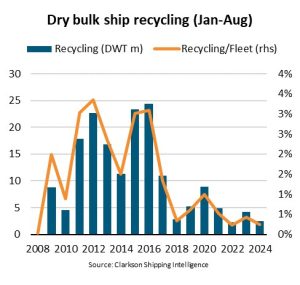In this week’s “Shipping Number of the Week” from BIMCO, Shipping Analyst, Filipe Gouveia, looks at the recycling of dry bulk ships which has reached the second lowest level in 16 years between January and August.
According to Filipe Gouveia, between January and August 2024, the number of recycled ships has dropped 42% y/y, the second lowest level in 16 years. The market has seen high freight rates and strong demand, delaying the recycling of older ships. On the supply side, the fleet has continued to grow slowly, limiting fleet renewal.

So far this year, only 45 ships have been recycled, adding up to 2.5 million deadweight tonnes (DWT) or 0.2% of the fleet. Recycling declined in all segments, with capesize and supramax experiencing the steepest fall, at almost half of last year’s figures.
Over the past three years demand shocks contributed to stronger than anticipated demand. Sanctions on Russian coal and rerouting away from the Red Sea and the Panama Canal all contributed to increased sailing distances, keeping ships at sea for longer.
On the supply side, the dry bulk sector has seen low deliveries and a small orderbook amid limited newbuild contracting, high newbuilding prices and uncertainty regarding new fuels.
Since 2021, competition for slots in shipyards has increased overall, first due to a boom in container and LNG orders and since 2023, a rise in contracting for crude and product tankers.
In the short term, fleet renewal will not be a significant challenge for the sector. The fleet is at its oldest since 2011, but only 9% of capacity is 20 years old or above. Furthermore, that is still younger than both the tanker and container fleets.
… said Gouveia.
Bulk carriers are typically designed to operate for around 25 years and only 3% of capacity is currently 25 years old or above. These older ships are particularly prevalent in the handysize segment, accounting for 8% of the segment’s capacity, while ships in the capesize segment seldom reach the age of 25 before recycling.
More ships will be replaced in the future to comply with future climate regulations, since energy and fuel efficiency will be key to decarbonising. Although ship design has not radically changed over the past twenty years, younger ships are marginally more efficient and make for better investment candidates for fuel saving technology due to their longer lifespan.
Over the coming years, ship recycling is anticipated to gradually rebound when transits through the Panama Canal and the Red Sea return to normal at some point, and the market adapts to other demand shocks. In a weaker market, older, less competitive ships that would have been recycled over the last three years will likely be phased out. In the medium term, stricter climate policy will further encourage recycling.
… Gouveia concludes






























































